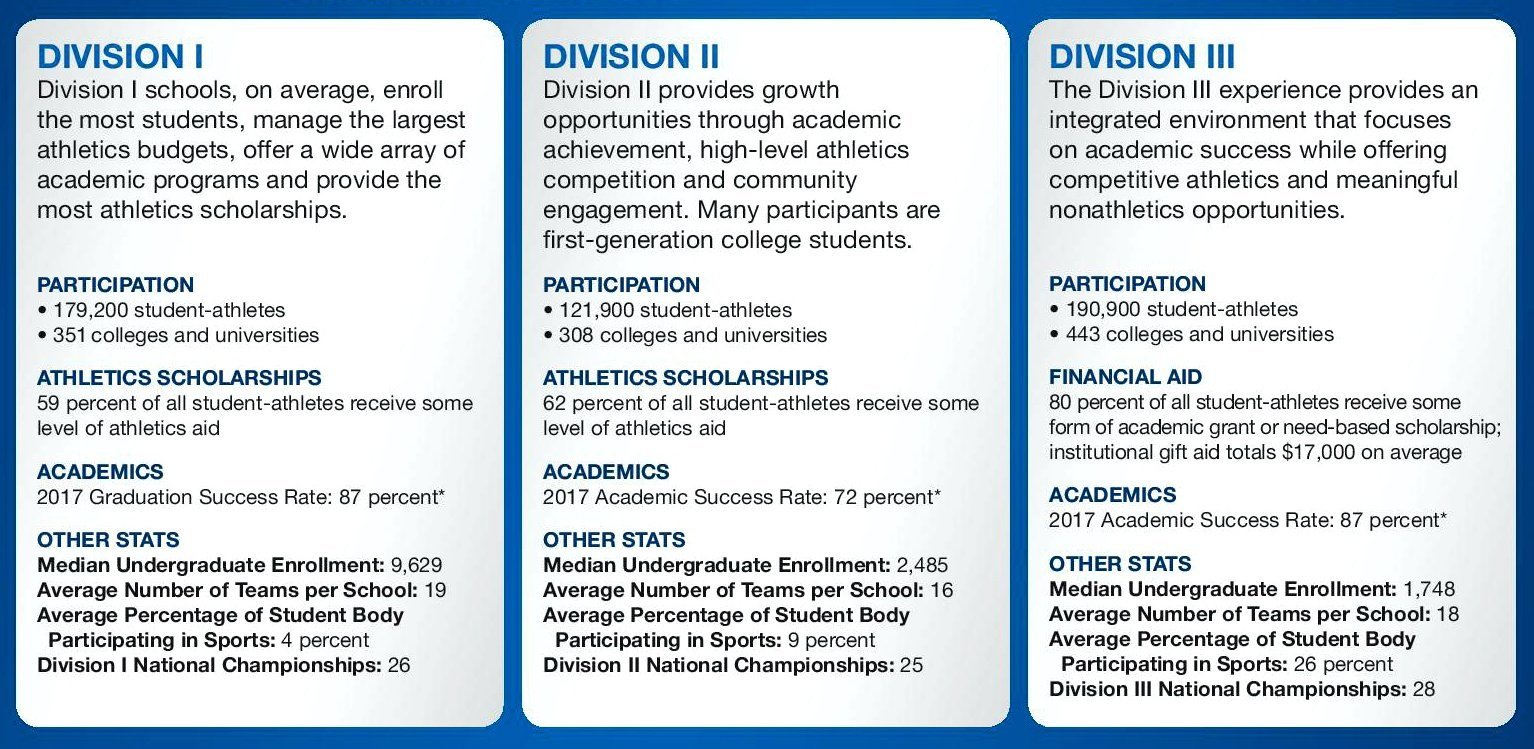How to Get Recruited for College Sports
By Lindsey Permar
A NOTE ON THE STUDENT-ATHLETE EXPERIENCE
Getting recruited to play college sports can be one of most thrilling experiences. Yet, the student-athlete experience varies quite a bit, depending on a range of factors, such as the division level, team dynamics, and coaching style. In the process of researching and visiting schools, it is important to be honest with yourself about what you want out of your college experience. If you got injured and could no longer play, would you still enjoy the school, apart from athletics? Avoid the pitfall of being “stuck” at a school you dislike by considering a school holistically.
NCAA DIVISIONS
Looking at the basic differences in the three NCAA divisions can give you an idea of what to expect as a student-athlete, but keep in mind that choosing the right school for you depends on a variety of factors, such as school size, location, academic opportunities available, and campus culture. Here are some quick stats by division provided by the NCAA:
Beyond the statistics, a school’s approach to athletics matters. A DI program, for example, is going to have a demanding schedule for a student. Between year-round practice and training, off-season competition, and travelling, there will be no time for other extracurriculars; however, you get the thrill of competing at the top level, and unless it is the Ivy League, you will also have the possibility of an athletic scholarship. DII schools are not as competitive as DI schools, but you may also have a better chance of getting playing time all four years. Finally, although DIII schools do not offer athletic scholarships, 80% of their student-athletes receive non-athletic aid, the highest percentage of all three divisions. DIII programs also offer a less rigorous schedule and make it a point to provide a more balanced student-athlete experience. Here is their official Philosophy Statement: “Colleges and universities in Division III place the highest priority on the overall quality of the educational experience and on the successful completion of all students’ academic programs.”
Other divisions, outside of the NCAA, include the NAIA (National Association of Intercollegiate Athletics), NJCAA (National Junior College Athletic Association), and the NCCAA (National Christian College Athletic Association). Deciding on the best program comes down to a range of factors, so be sure to do your due-diligence to figure out which division and program is right for you!
TIMELINE
Here is a timeline covering the steps you can take, from freshman to senior year, to get recruited as a student-athlete.
FRESHMAN YEAR: GRADES + CONDITIONING
Regardless of your athletic prowess, your grades are crucial, especially if you are hoping to be recruited by a school with competitive academics. As such, make it a priority to strive for academic excellence and begin your high school career with strong grades. Physically, this is a good time to focus on conditioning. Talk with your coach and/or reach out to your school’s athletic trainer or a local gym to develop the best conditioning program for your sport. Work on getting strong for your sport and keep your body in prime shape. Participate on your high school team and also a travel team, if appropriate for your sport. If you haven’t already, find an expert coach who can help guide you to be the best athlete you can be. Finally, seek out a college camp in which to participate during the summer.
SOPHOMORE YEAR: GRADES, CONDITIONING, RESUME-BUILDING
In the fall, continue working hard on your conditioning program as well as your academics (grades determine college admissions!). In the Spring, start developing a list of colleges for whom you might want to play. From this list, choose summer sports camps in which you could participate. Also around this time, start developing an athletic resume that highlights your athletic achievements. This resume will be a good starting point to organize your experience and achievements; it is also something you will add to in the next year. During this time, also be sure to register with the NCAA Eligibility Center to ensure that you are on track to meet the eligibility requirements for an NCAA program.
JUNIOR YEAR – FALL
FINALIZE RECRUITMENT MATERIALS & COLLEGE LIST, TRACK COACH COMMUNICATION
Your top priority should still be working for top grades. Here are other to-do’s for the fall of your junior year.
Refine your sport recruiting college list
For each college of interest, complete online sports team recruiting questionnaires, which will put you on the coach’s radar.
Finalize your athletic resume with updated information.
Find the contact information for coaches and establish a database of contact information in an Excel spreadsheet or Word Doc.
Request a letter of recommendation from your coach and ask if he/she would be willing to reach out to specific colleges on your behalf.
While waiting on your coach’s recommendation letter, work to prepare a video to be sent out.
Consider making a profile on a recruiting website (like BeRecruited, NCSA, or CaptainU). The recruiting websites can ensure you’re sending the right information to coaches, and they can provide you with contact information for college coaches. Alternatively, consider developing your own web page that offers easy access to all of your materials: resume, video, any news features, etc.
Craft an initial email to college coaches, which includes your athletic resume, coach’s letter of rec, and video. After careful review, send!
Be sure to coordinate communications with your high school/club coach so that introductory emails from your coach do not overlap with your own direct-to-college-coach emails.
Continue logging all contacts with coaches.
Prepare for college visits. Official visits can start as early as August 1st before a student’s junior year (except for basketball where official visits can begin January 1st for men’s and April 1st for women’s. NOTE: The NCAA only allows recruits to take 5 official visits for DI and DII, while DIII visits are unlimited.
JUNIOR YEAR—SPRING
CONTINUED COACH CONTACT, SUMMER PREPARATION
Around April, prepare a second letter, sharing your continued interest and also your:
tournament and showcase schedule
list of camps attending
GPA, SAT scores
list of all AP and Honors courses being taken in your senior year
You’ll be reaching out to a lot of coaches! Be sure to keep track of all communication in your Excel spreadsheet or Word Doc. Communicating directly and periodically with coaches not only shows your interest in the program but also makes it easier for them to stay updated on your successes and schedule.
SENIOR YEAR: TRANSCRIPT REQUEST, UPDATES
Over the summer, complete a transcript request to send transcripts to NCAA’s Eligibility Center. If you have not been recruited as strongly as you’d like, don’t panic! Although top DI programs will likely have filled their rosters, there are plenty of programs out there who are still recruiting into an athlete’s senior year. If you haven’t already, look closely at DIII programs of interest as many have later timelines than DI schools. Update your recruitment video with more recent footage and highlights; include this in a follow-up email to coaches. Also consider calling a coach—they receive a ton of emails from potential recruits but probably not too many phone calls. Continue talking with any and every coach you know for any connections to college coaches—these types of personal connections can help get your foot in the door.
A FINAL WORD
Getting recruited to play college sports can be one of most thrilling experiences. Yet, if you find yourself in the unexpected position of having not been recruited and still very much want to be a collegiate athlete, consider trying out for the team as a walk-on. If that proves unfruitful, think about ways to leverage your athletic prowess for other athletic opportunities. Rowing, for example, welcomes novices, and soccer players often perform well as runners. There are also club sports to consider. College is one of the last times in your life where you will bombarded with extracurricular options to explore with your peers—take advantage of this in any way you can, even if it looks a little different than what you initially expected. If you do not get the opportunity to be a collegiate athlete, you no doubt have still grown tremendously from competing at a top level throughout your high school years and nobody can take that away from you.


